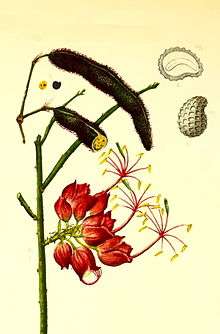Cadaba aphylla
| Cadaba aphylla | |
|---|---|
 | |
| Scientific classification | |
| Kingdom: | Plantae |
| (unranked): | Angiosperms |
| (unranked): | Eudicots |
| (unranked): | Rosids |
| Order: | Brassicales |
| Family: | Capparaceae |
| Genus: | Cadaba |
| Species: | C. aphylla |
| Binomial name | |
| Cadaba aphylla (Thunb.) Wild | |
| Synonyms | |
| |
Cadaba aphylla is one of some 30 species in the genus Cadaba. It grows as a straggly, perennial shrub or small tree, virgate, much-branched, dark green, often with purple bloom, and usually leafless, and may reach 2 m in height. Its branches are somewhat succulent and frequently spine-tipped. Leaves of some 10 x 2 mm are found on seedlings and young branchlets. Its deep red flowers (rarely yellow) in axillary clusters have prominently exserted stamens, making this a colourful plant in summer. Fruits are some 90 mm in length, green at first, turning a rusty brown when mature, and covered in sticky hairs. A sticky orange pulp covers the small black seeds. This species may occur in dry bushveld or semidesert conditions from tropical Africa to Namibia, Zimbabwe, Botswana, and South Africa. [1]
"Leafless, twiggy shrub to 2 m. tall; branches rather virgate, stiff, smooth, green or glaucous with subspinous apices, glabrous, young branches with subulate leaf scales up to 2 mm. long. Flowers in short, corymbose, axillary racemes; rhachis 0.3–2.3 cm. long, glabrous or glandular-pubescent; bracts subulate, c. 1 mm. long; pedicels glabrous or glandular-pubescent, up to 1.3 cm. long. Sepals 4, yellow or reddish-purple, 1–1.7 x 0.7–1 cm., the lowest rather larger than the remainder, connate at the base into a very shallow receptacle c. 1 mm. in depth, broadly elliptic, obtuse at the apex, with capitate, glandular hairs densely or sparsely scattered on both sides. Petals 0. Androgynophore 2.5–3 mm. long, glabrous, shallowly declinate with a hooded nectary at its base c. 4 mm. broad. Stamens 8; filaments 1 cm. long; anthers 2.3 x 0.75 mm., oblong. Gynophore c. 1 cm. long, glabrous or glandular-pubescent. Ovary narrowly cylindric, glabrous or glandular-pubescent; ovules numerous, on 2 placentas; stigma capitate, sessile. Fruit up to 8 x 0.4 cm., cylindric, subtorulose, glandular or minutely verrucose, many-seeded. Seeds brown, c. 0.3 cm. in diam., subglobose."— Hiram Wild (Flora Zambesiaca)
